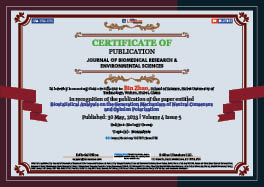Bin Zhao* and Xia Jiang
Volume4-Issue5
Dates: Received: 2023-04-11 | Accepted: 2023-05-20 | Published: 2023-05-30
Pages: 900-916
Abstract
We establish a biostatistical model to describe the generation mechanism of neutral consensus and opinion polarization. The paper also explores the formation mechanism of the "screaming effect", "echo chamber effect" and "information cocoon room" and studies how to use reasonable strategist avoid the "screaming effect" and "echo chamber effect" according to the biostatistical model built.
FullText HTML
FullText PDF
DOI: 10.37871/jbres1752
Certificate of Publication

Copyright
© 2023 Zhao B, et al. Distributed under Creative Commons CC-BY 4.0
How to cite this article
Zhao B, Jiang X. Biostatistical Analysis on the Generation Mechanism of Neutral Consensus and Opinion Polarization. J Biomed Res Environ Sci. 2023 May 30; 4(5): 900-916. doi: 10.37871/jbres1752, Article ID: JBRES1752, Available at: https://www.jelsciences.com/articles/jbres1752.pdf
Subject area(s)
References
- Cinelli M, Gianmarco De FM, Alessandro G, Walter Q, Michele S. The echo chamber effect on social media. Proceedings of the National Academy of Sciences. 2021;118:9. doi: 10.1073/pnas.2023301118.
- Guess A, Brendan N, Benjamin L, Jason R. Avoiding the echo chamber about echo chambers. Knight Foundation. 2018;1-25.
- Harko T, Francisco SNL, Mak MK. Exact analytical solutions of the Susceptible-Infected-Recovered (SIR) epidemic model and of the SIR model with equal death and birth rates. Applied Mathematics and Computation. 2014;236:184-194. doi: 10.1016/j.amc.2014.03.030.
- Lee JK, Jihyang C, Cheonsoo K, Yonghwan K. Social media, network heterogeneity, and opinion polarization. Journal of Communication. 2014;64(4):702-722. doi: 10.1111/jcom.12077.
- Wang D, Yuxing Q. Echo chamber effect in rumor rebuttal discussions about COVID-19 in China: Social media content and network analysis study. Journal of Medical Internet Research. 2021;23(3):e27009-e27009. doi: 10.2196/27009.
- Wesley C, Silvio CF, Romualdo PS, Starnini M. Quantifying echo chamber effects in information spreading over political communication networks. EPJ Data Science. 2019;(8)1:1-13. doi: 10.1140/epjds/s13688-019-0213-9.
- Siying D, Steve G. The echo chamber effect in Twitter: does community polarization increase? International workshop on complex networks and their applications. Springer, Cham. 2017;693:373-378. doi: 10.1007/978-3-319-50901-3_30.
- Seth F, Sharad G, Justin MR. Filter bubbles, echo chambers, and online news consumption. Public Opinion Quarterly. 2016;80(S1):298-320.
- Del Vicario M, Bessi A, Zollo F, Petroni F, Scala A, Caldarelli G, Stanley HE, Quattrociocchi W. The spreading of misinformation online. Proc Natl Acad Sci U S A. 2016 Jan 19;113(3):554-9. doi: 10.1073/pnas.1517441113. Epub 2016 Jan 4. PMID: 26729863; PMCID: PMC4725489.
- Wei L, Zhou W. Research on solving path of negative effect of “Information Cocoon Room” in emergency. Discrete Dynamics in Nature and Society. 2022;(579):1-12. doi: 10.1155/2022/1326579.
- Gossart C. Can digital technologies threaten democracy by creating information cocoons? Transforming politics and policy in the digital age. IGI Global. 2014;145-154.
- Peng H, Chang L. Breaking the Information cocoon: When do people actively seek conflicting information? Proceedings of the Association for Information Science and Technology. 2021;58(1):801-803. doi: 10.1002/pra2.567.
- Florencia L, Cynthia AU, Juan CR, Cecilia De MM. Acoustic discrimination by hosts favors vocal trickery in fledglings of the brood-parasitic screaming cowbird Behavioral ecology and sociobiology. 2022;76(71):1-11. doi: 10.1007/s00265-022-03175-9.






























































